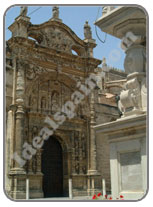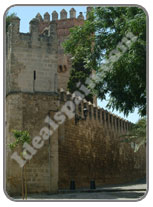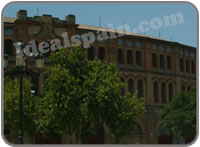|
|
Places in Spain -
Puerto de Santa Maria, Cadiz, Costa de la Luz, Andalucia
|
El Puerto de
Santa Maria is
located
slightly north
of
Cadiz,
within the
province of
Cadiz, on the
Guadalete
River outlet,
in the Bay of
Cadiz.
El Puerto de
Santa Maria is
situated in
the middle of
the Parque
Natural Bahia
de Cadiz (Bahia
de Cadiz
Natural Park),
and is limited
by two large
strips of
land. The
famous port is
one of
Andalucias'
tourist
hotspots. El
Puerto de
Santa Maria
enjoys a
Mediterranean
climate and a
relaxed, calm
atmosphere
away from the
hustle of
international
business and
tourism. The
area, however,
is a popular
holiday
destination
for Spaniards.
El Puerto
gazes out
across the
Atlantic Ocean
and is part of
an area in
Spain known as
the "Coast of
Light" (Costa
de la Luz).
The city is
located
between
Jerez
and
Cadiz,
on the Bay of Cadiz. Both El Puerto and Cadiz have a rich history as
Phoenician trading colonies dating back some 3,000 years.
|
|
|
|
The seafood
dishes of the
region will
surely tempt
your palette.
The area is
also famous
for its
festivals and
holidays such
as the
Carnival, Holy
Week, local
fairs, and
singing and
dancing
celebrations.
The region is
said to be the
birthplace of
Flamenco
dancing, which
will capture
your
imagination.
Despite the
unattractive
approach to
Puerto de
Santa Maria, a
visit will be
well rewarded.
The port has a
wonderful
beach, the
Playa Puntillo
and a charming
town centre
that is not
spoilt by
heavy traffic.
The cobbled
streets are
lined with
traditional
Andalucian
architecture.
Just like
neighbouring
Jerez,
Puerto de
Santa Maria is
famed for its
sherry. Before
the train line
was extended
through to
Cadiz, all
sherry from
Jerez came
through Santa
Maria.
History of El
Puerto de
Santa Maria
The First
traces of
settlements in
El Puerto de
Santa Maria,
are from the
lower
Palaeolithic
period, as
demonstrated
by the remains
at "El
Aculadero".
Other
archaeological
sites of great
interest are
"Las Arenas"
and "Doña
Blanca" dating
back to the
Phoenicians,
sometime
between the
8th and 9th
centuries B.C.
Legend has it
that the City
was founded by
an Athenian
leader,
Menestheo
who after the
Troyan Wars,
founded a city
which he named
after himself,
Puerto de
Menesteo. |
| |
|
|
| |
| |
|
|
| |
|
In the year
711 the Muslims fought and won a battle against the Visigoth
Armies known as the Battle of the Guadalete. From that moment on
the city was incorporated into the Muslim territory and its name
was changed to
Amaria
Alcanter,
Alcanatif,
or
Alcanate,
which mean 'Port of the salt mines', Arch or Bridge. In the year
1260, the city was taken from the Moors by Alfonso X, who named it
Santa
Maria del Puerto, and who organised the distribution of the
land among the new settlers. From 1368 to the 18th century El
Puerto was under the Lordship of the
Medinaceli
family, and it was during this period that the city had its
greatest days of glory. Christopher Columbus was a guest of the
rich families of El Puerto who also helped him to prepare for the
voyage which would lead him to the Discovery of the New World |
 |
|
|
|
It was here
that the Santa Maria was fitted out; this ship was the property of
Juan de la Cosa, a sailor who was a pilot for Columbus in
1492 and, who in 1500, made the first world map ever known to
include the newly discovered continent of America. During the 16th
and 17th centuries, El Puerto was the winter headquarters and base
for the Royal Galleys and the site of the General Captaincy of the
'Mar Océana'. This fact would determinate the role the
city played in the preparations of important naval expeditions.
Visiting El
Puerto de
Santa Maria
San Marcos´s
Castle
This
is
one of the
most important
buildings in
the city. Its
towers and
battlements
stand out
against the
skyline of El
Puerto, they
constitute an
unmistakable
silhouette and
probably one
of the oldest
images in the
architectural
monuments of
El Puerto.
Originally the
castle was an
old mosque,
the most
important
building in
the Muslim
village of Al-Qanatif.
It was erected
with materials
that probably
came from
another, older
Roman
building.
|
|
|
|
The castle has
three naves
divided in
four phases,
patio "sahn",
minaret or
tower and the
main wall or
wall of the "quibla"
in whose
centre a
sacred
enclosure was
opened "the
mihrab". Both
the wall of
the "quibla"
and "the
mihrab" are
still
conserved in
the modern
construction.
An old
inscription
belonging to
this time can
be found on
one of the
earliest
entrances to
the building.
The second
stage of the
building
belongs
together with
its
transformation
into a
Christian
sanctuary, to
the middle of
the XIII
century and
linked to the
Castilian
conquest of
the area by
Alfonso X
between the
years 1257 and
1260. The
occupation by
Alfoso X "Alfonsí"
was bound to
the election
of the castle,
magnificently
located as the
defensive
point of the
whole district
and centre of
provisioning
of the
Castilian
fleet for its
expeditions.
Some years
later it
suffered some
remodelling at
the same time
that the city
was enclosed
by a wall.
Possibly in
1272 it
entered into
the Order of
Santa María of
Spain. |
 |
|
In the
church
fortress
of Santa
María
known as
the Castle
of San
Marcos
from the
XIV-XV
centuries
stone and
Roman
columns
were used.
Several of
these
columns,
today
embedded
into
interior
pillars,
are
conserved.
This
reformation
and
Christian
construction
was begun
by the
master
builder
Ali
in the
first
years of
the
Castilian
occupation
and the
building
was soon
transformed
into an
important
pilgrim
centre
that would
be
highlighted
as a
peculiar
element of
the town.
The
reconstruction
affected
the castle
in its
entirety
with a
series of
important
transformations
both in
the
exterior
and
interior.
The Castle
was
headquarters
of the
Town hall
up to
1729, year
in which
El Puerto
de Santa
Maria
forms part
of the
Castilian
Crown
after a
long
period of
elegant
dependence
under the
rule of
the Duke
of
Medinaceli.
It was
used as a
church
until the
XIX
century
and later
it would
be
readapted
for
housings,
until the
middle of
the
present
century
the last
great
remodelling
was
undertaken,
in which
the
building
acquires
its
present
image.
The
improvements
made in
1943 by
the
researcher
D.
Hipólito
Sancho of
El Puerto,
restoring
both
interior
and
exterior,
reunifying
its double
Islamic-Gothic
origin:
horseshoe
arches and
ornamental
elements
were added
to the
interior
as well as
Cordovan
leathers,
stained
glass
windows, a
grill, and
in the
interior,
the
covering
of the "mihrab".
On the
exterior,
the
pictorial
decoration
of castles
and lions
and the
marine
legends,
also the
whole
restoration
of towers
and
battlements
that were
in a
terrible
condition
correspond
to that
period.
Both
Almohade
and Gothic
styles
melted
together
once again
as it was
in its
early
origins.
Recently
new
maintenance
work on
the
building
and the
restoration
of the
external
wall and
towers
have taken
place.
Once more
in free
times, San
Marcos´s
castle is
today
found in
the heart
of the
city and
constitutes
the main
facade of
the
traditional
square
that
shares its
name with
of the
king which
ordered
its
reconstruction
in the
time when
the city
was being
established.
Declared
of
Cultural
Interest
from 1920
then with
a category
of
National
Monument
its walls
guard the
Gothic
image of
El Puerto
de Santa
María from
a Spain of
the
XII-XIII
centuries,
so linked
to El
Puerto.
Just as in
the past,
the Castle
of San
Marcos
continues
being an
unmistakable
symbol of
El Puerto.
Its tower
of the
Homage,
with the
Patron´s
image, are
present in
the local
coat of
arms and
its jagged
profile
is, almost
inextinguishable,
in its
urban
image.
The castle
is open on
Tuesdays,
Thursdays
and
Saturdays,
11:00 to
13:30.
Tuesday
admission
free,
other
times
1,80€,
1,20€
children.
Phone: 956
851 751
Fax: 956
853 462.
Main
Priory
Church
The Dukes
of
Medinaceli,
Gentlemen
of El
Puerto de
Santa
Maria,
ordered
the
construction
of the
church
which
began in
1486,
lasting
until the
XVIII
century.
The first
phase of
the
construction
is by the
master
builder
Alonso
Rodríguez
who also
worked on
the
cathedral
of
Seville.
Both of
these
buildings
as well as
others in
Jerez and
of the
rest of
the area
were built
with sand
stone from
the
quarries
of San
Cristobal´s
Sierra.
|
The
bullring
Bullfighting
in El
Puerto de
Santa
María, is
one of the
strongest
and deeply
rooted
traditions
in Spain.
El Puerto
de Santa
Maria has
an old
prestige
for
bullfights.
Already
before the
times of
Pepe Hillo
or Pedro
Romero
from
Ronda, it
had well
rooted its
fame for
bullfighting
in the
city: the
old
bullring
in Galeras
Square
which
replaced
the older
one of
scaffoldings
in
Polvorista
Square and
that was
an advance
of wooden
bullrings
in the
same place
where
today we
find the
stone,
iron and
brick
bullring,
built at
the end of
the 19th
century;
one of the
most
beautiful
bullrings
in all of
Spain.
|
 |
|
|
The
building
is a
regular
polygon
of 60
sides,
with a
diameter
of
99.8
metres;
this
surface
area
is
distributed
as
follows;
an
external
gallery,
above
a
second
and
third
gallery
where
the
royal
and
the
presidential
boxes
are
found
and
the
covered
stands,
also
the 16
stone
seated
sections
known
as "Tendidos";
it has
a
capacity
for
over
twelve
thousand
people.
The
arena
is 60
meters
in
diameter,
one of
the
widest
that
exists.
It is
separated
from
the
public
by a
two
meter
alley
with a
barrier.
The
management
of its
construction
was
carried
out by
the
"Bullring
Company",
presided
over
by D.
Tomás
Osborne
and
Bölh
de
Faber,
descendant
of the
family
of "
Fernán-Caballero
" the
illustrious
writer.
To
mark
the
centenary
celebrations
of the
bullring,
another
ceramic
tile
was
placed
in
front
of the
one
that
reminds
us of
the
unforgettable
sentence
of
Joselito
"El
Gallito".
It was
inaugurated
on the
5th
and
6th of
June
1880
with
two
bullfights
in
which
Antonio
Carmona
Gordito,
of
Seville,
and
the
Cordovan
Rafael
Molina
Lagartijo,
fought
bulls
from
the
ranch
of
Anastasio
Martín
and of
Saltillo.
"
Bordador
", was
the
name
of the
first
bull
that
was
fought
in the
bullring,
and
its
crowned
head
can
still
be
seen
in the
Reception
Room.
The
fair
of El
Puerto
is
held
in the
summer
when
bullfights
are at
their
best.
|
Fiestas
and
celebrations
The
carnival
in El
Puerto
has a
well
deserved
prestige
and
has
taken
place
since
the
18th
century.
Holy
Week.
With
its
processions,
floats,
religious
songs,
Holy
Week
in El
Puerto
takes
on a
mixed
religious
and
popular
character.
Every
day
during
Holy
Week,
the
Fraternities
and
Brotherhoods
of El
Puerto,
some
of
which
date
back
centuries
and
are of
strong
tradition,
take
their
religious
images
out to
the
streets
among
which
some
could
be
highlighted
for
their
artistic
size
and
are of
great
interest
and
quality,
carried
on the
shoulders
of the
members
of the
Fraternities
and
Brotherhoods
and
guarded
by
hundreds
of
penitents.
Spring
Festivity.
Celebrated
in May
this
festivity
is
part
of the
big
Andalucian
fairs,
the
Spring
Fair,
a
celebration
that
has a
clear
connection
to the
welcoming
of the
new
fruits
that
germinate
in the
season
that
gives
it its
name.
Corpus
Christi.
A
religious
festivity
which
reaches
its
maximum
expression
in the
evening
procession
that
leaves
of the
Mayor
Prioral
Church
and
circulates
through
the
main
streets
of El
Puerto
de
Santa
Maria.
The
Seafaring
Festivity,
"Virgin
del
Carmen".
16th
July,
day of
the
Virgin
del
Carmen,
a
celebration
with
clear
seafaring
roots.
The
traditionally
seafaring
character
of El
Puerto
de
Santa
Maria
has
offered
a
special
devotion
to the
Virgin
del
Carmen.
A
traditional
evening
festivity
of the
summer
in El
Puerto
that
formerly
marked
the
beginning
of the
season,
and
the
festival
acts
organized
by the
sailors,
summon
the
whole
population
and
the
numerous
summer
visitors
that
are
here.
The
procession
is
accompanied
by a
fireworks
display.
Festivity
of the
Patroness
"Virgen
de los
Milagros".
The
festivity
of the
Virgin
de los
Milagros
takes
place
on
September
8th,
the
most
important
festivity
of El
Puerto.
Along
with
the
religious
acts,
there
is the
traditional
celebration
of the
procession
of the
Patron
Saint
through
the
streets
of El
Puerto,
adorned
with
flowers
and
with a
special
stop
at San
Marcos's
Castle.
|
|
| |
|
|
|
|

